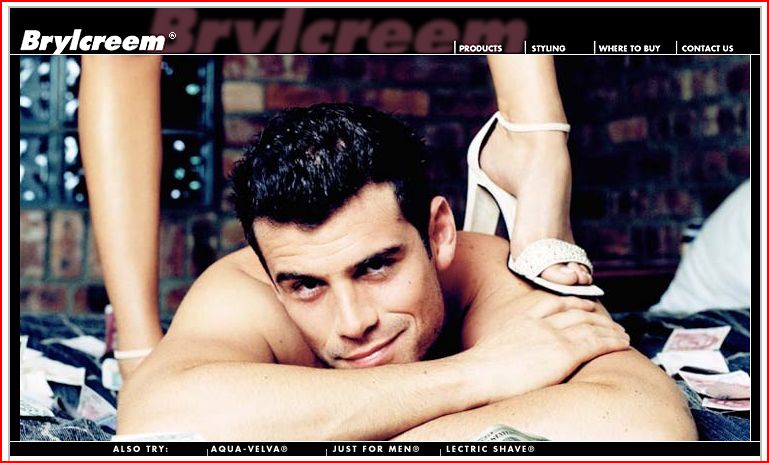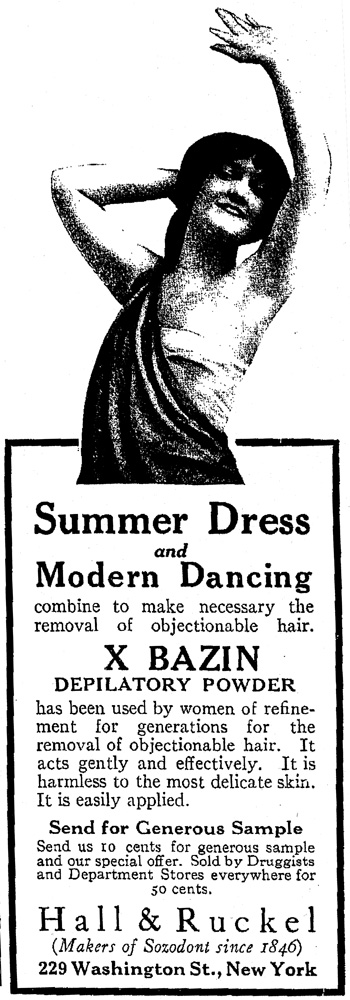Laura K. brought our attention to these ads with not-so-subliminal sexual content (via haha.nu). Some of them are so-not-so-subliminal that they may not be safe for work.
media: marketing
In this series, I offer a typology reflecting the ways in which people of color are used in advertising aimed primarily at whites (see the first and the second in the series). In this, the third edition, I suggest that sometimes people of color are included because the idea of “diversity” triggers the related ideas of “cool,” “hip,” “urban,” and “youth,” which also invoke “modernity” and the idea of being “global,” “cosmopolitan,” even “progressive” politics.
In this ad, a mix of races are used. Notice that the ad also happens to include, in the bottom image, photography, what looks like a dark beer, and espresso (all “upper class” “sophisticated” interests) and, in the top image, we see that the woman who appears Asian is an art dealer.
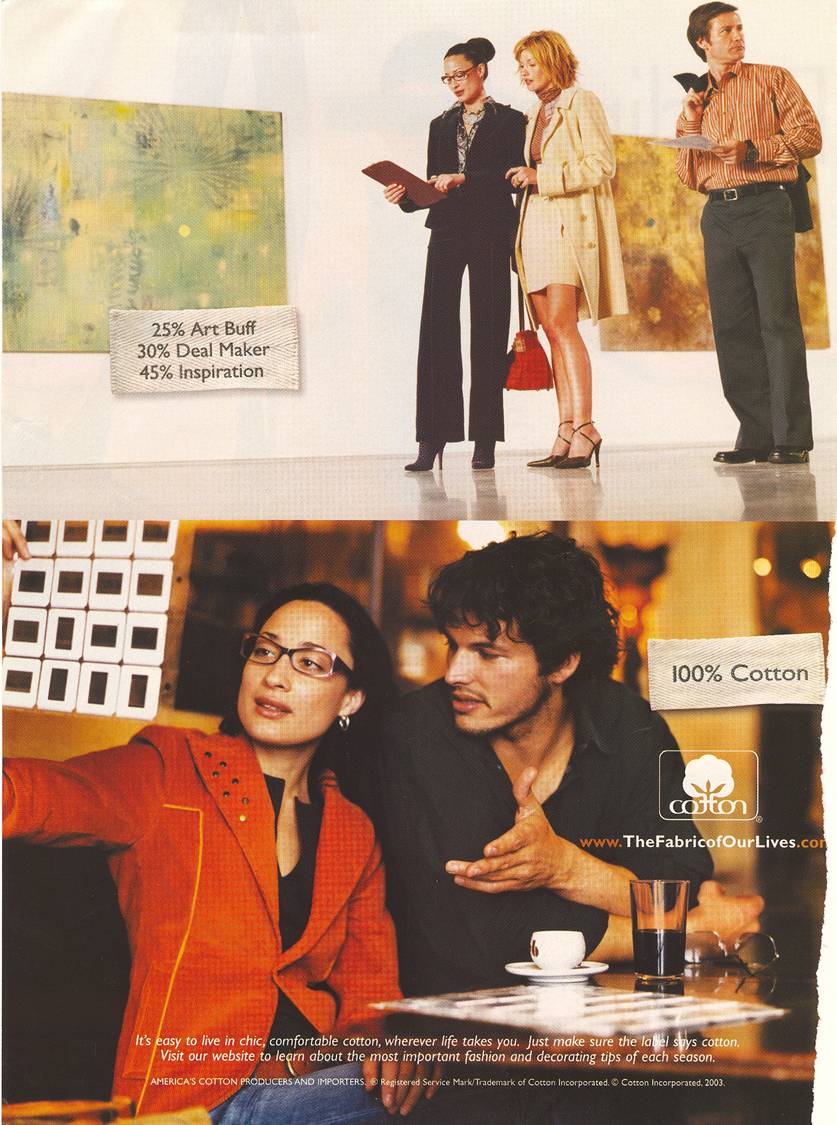
In this next ad, again, we see a mix of races enjoying what looks like a train ride (how European!) with hard liquor. The text:
The shortest distance between two places isn’t nearly as interesting.
I think it is no accident that “interesting” and racial difference are both present in this ad.
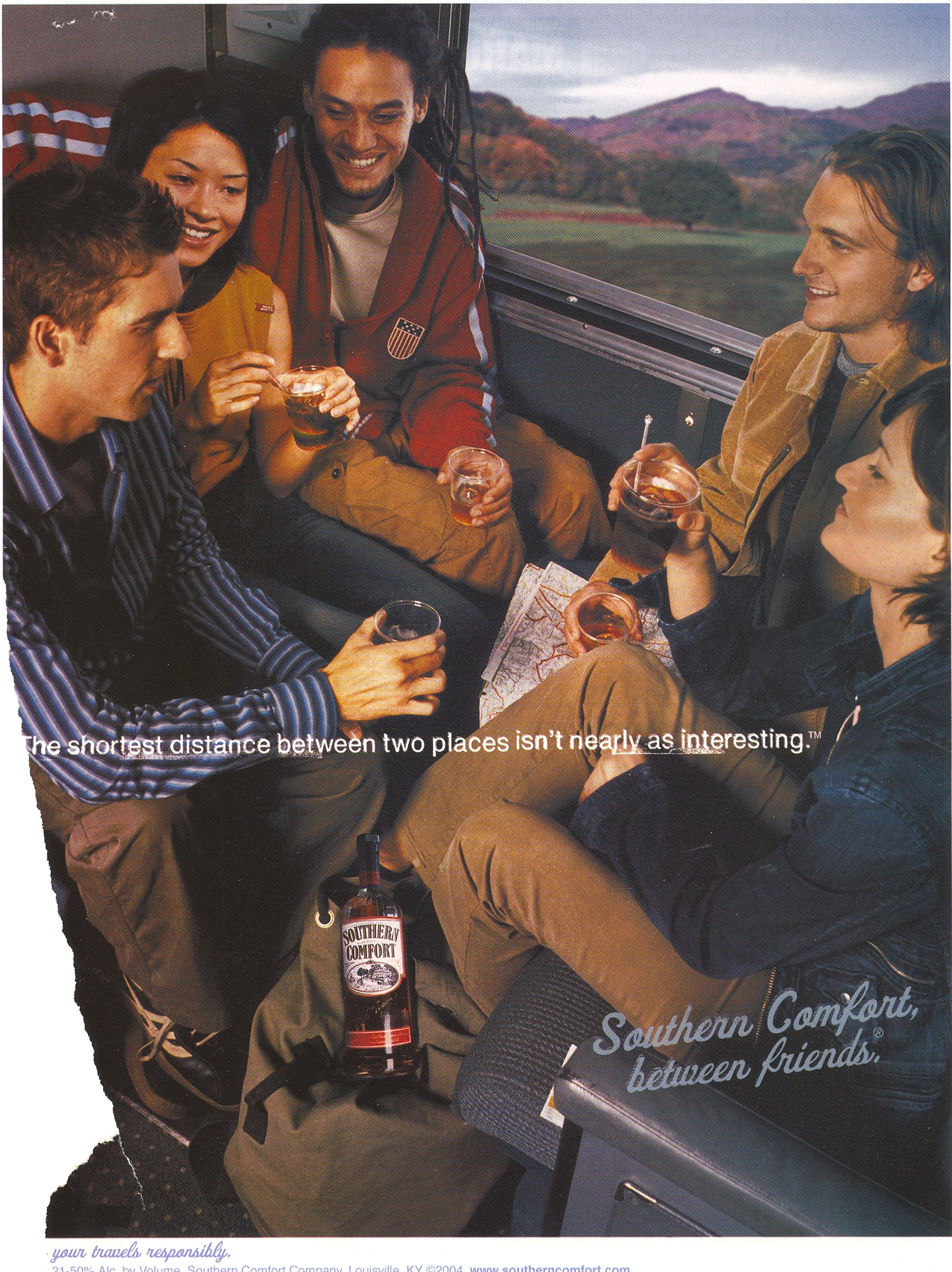
In this next ad we see a racially ambiguous male and a black woman. Notice the clothes that they are wearing (casually sophisticated) and the delicate nature of their coffee cups. This is leisure, not some working-class Joe with a cup o’ joe. Text:
3658 miles from the coffee fields of the Columbian Andes. But still the perfect climate for Colombian Coffee.
The idea of travel, of course, invokes a certain degree of cosmopolitan-ness and wealth. And the “perfect” climate refers not just to weather, but to the kind of company Colombian Coffee drinkers keep.
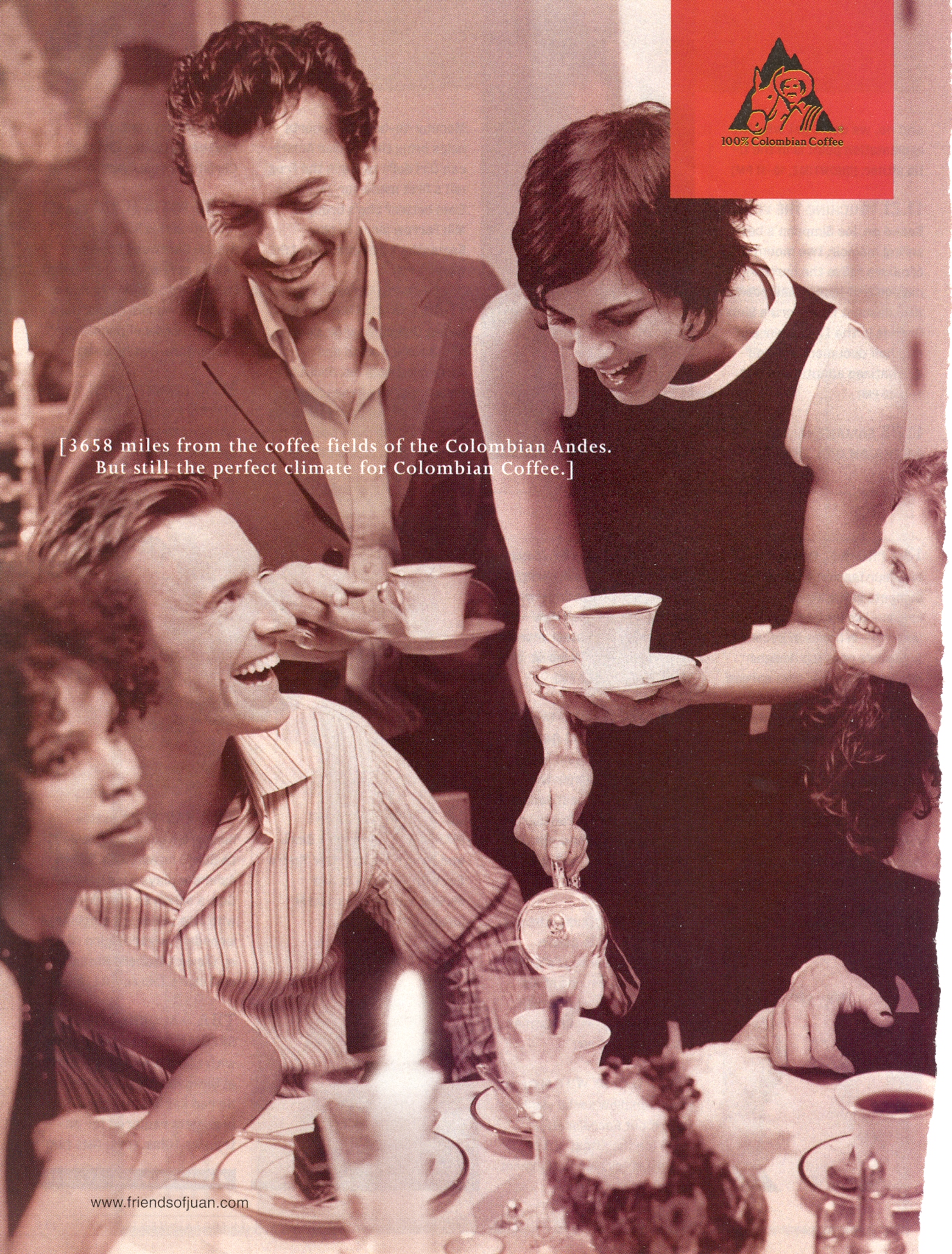
This ad for H&M is a bit different. Instead of invoking sophistication and cosmopolitan-ness, I think it invokes who and what is “hip” and “cool” and “diversity” is used as a signifier. The text:
H&M is Europe’s leading fashion retailer [Europe again], with over 850 stores worldwide [a reference to being “global”]. Offering high-fashion [i.e., “sophisticated?”] and quality for men, women and children at great prices.
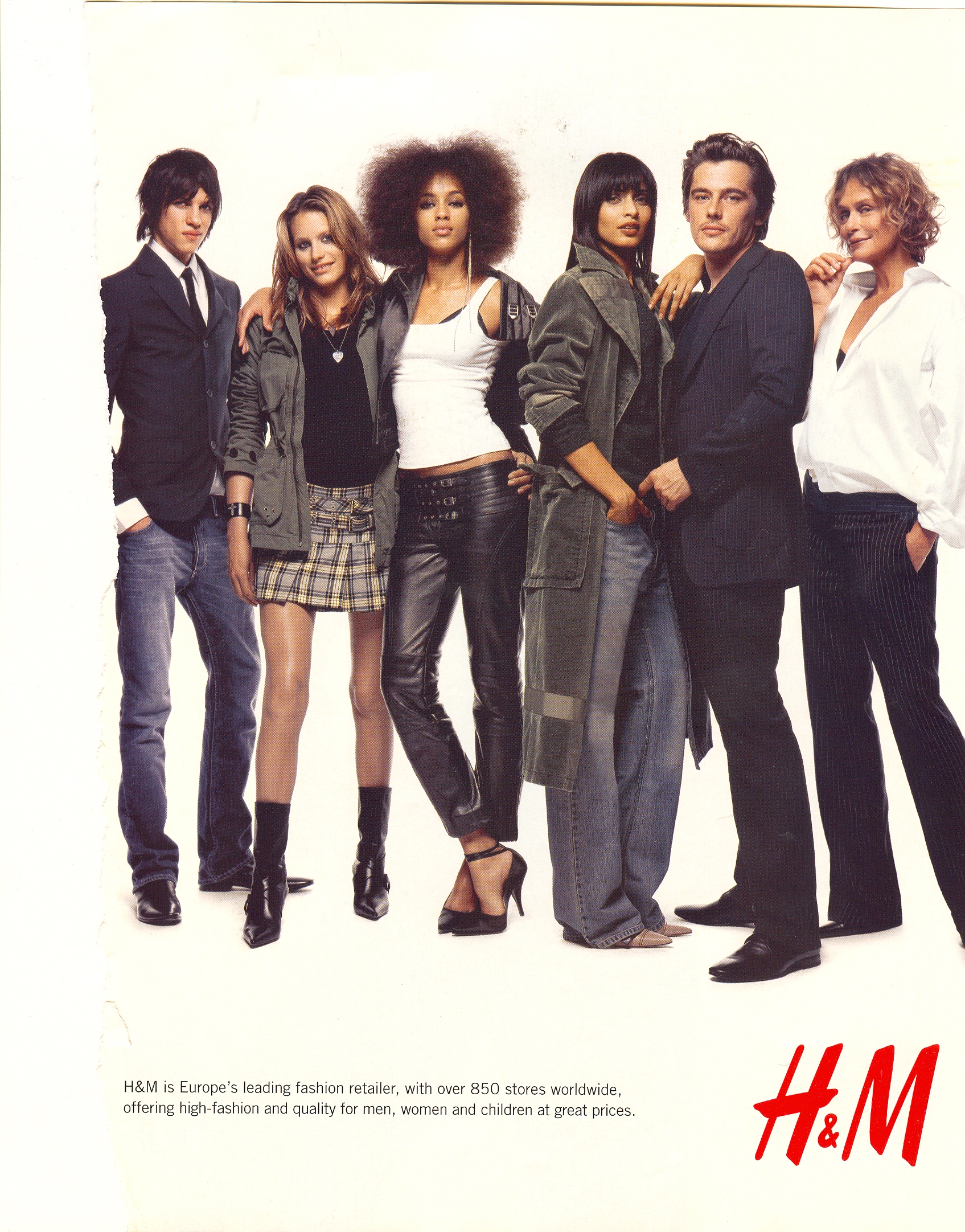
These last two ads, instead of using people of color to emphasize being “hip” or “sophisticated,” use them to signal “youth” and what being young represents. Young people are on the forefront of “cool,” of course, and also, in some sense, define “progressive” in that they herald a more “diverse” and “tolerant” future (hello, Obama).
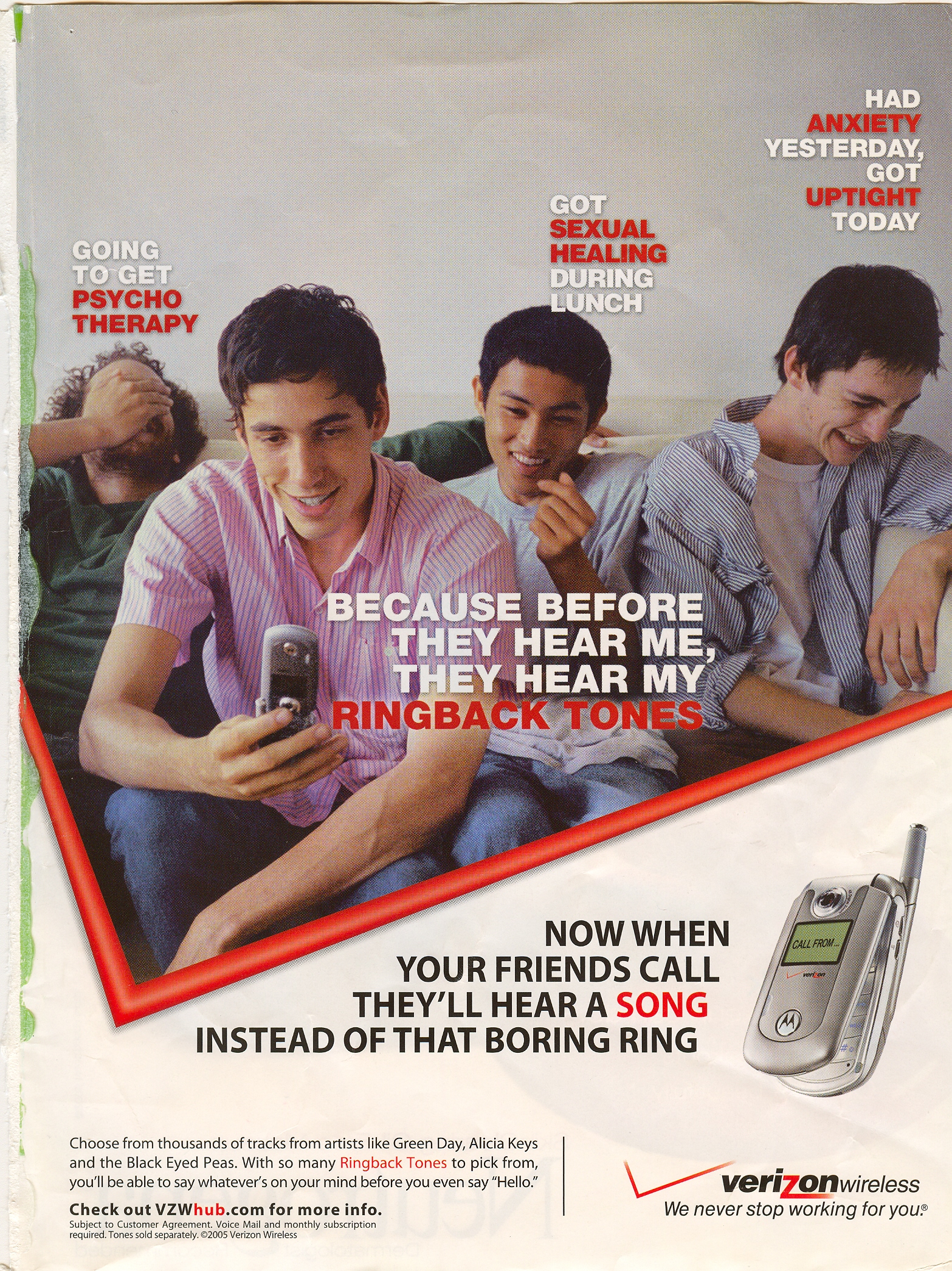
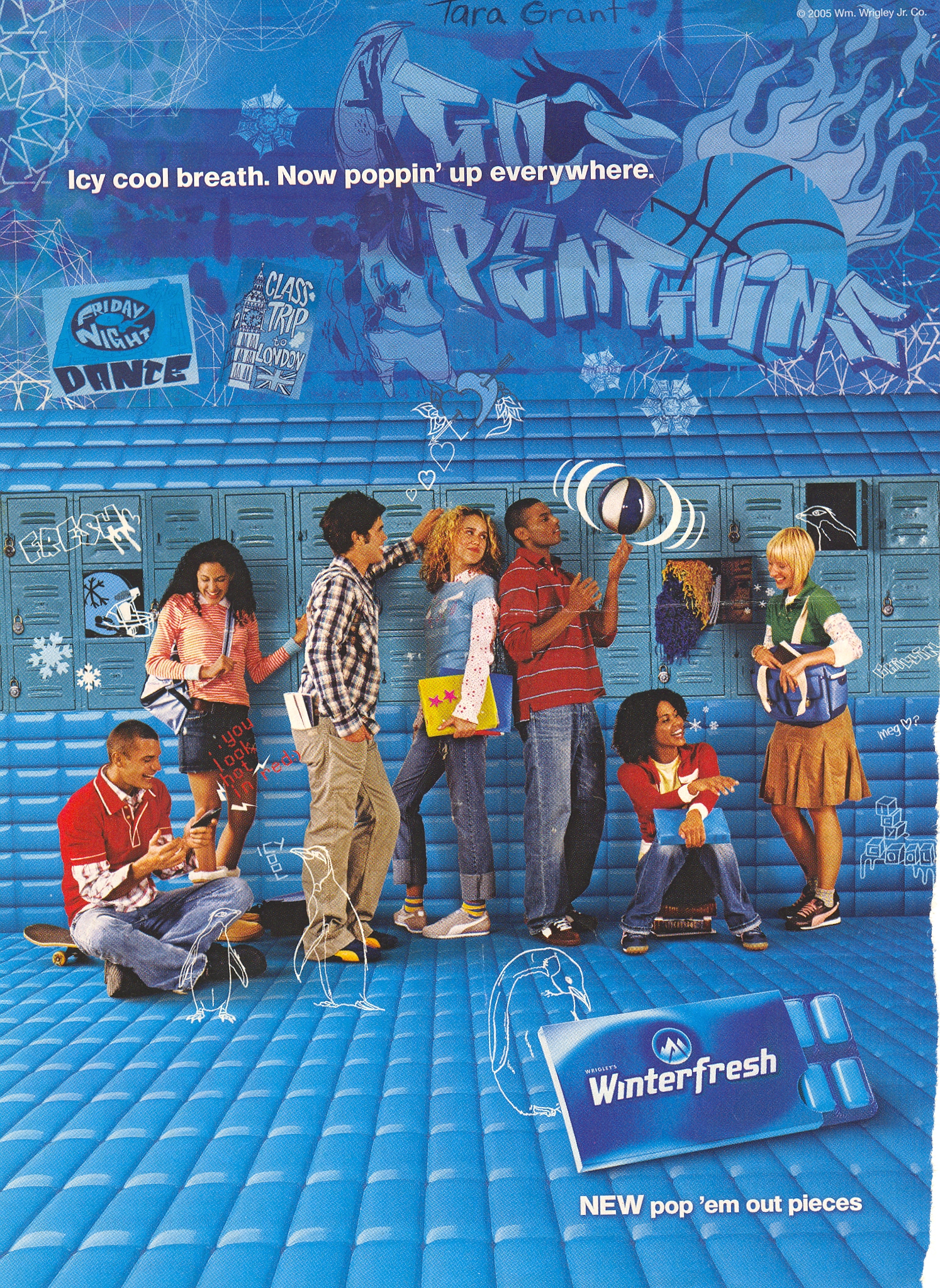
Next up: Including people of color so as to trigger the idea of human diversity.
Don’t miss the others in the series:
(1) Including people of color so as to associate the product with the racial stereotype.
(2) Including people of color to invoke (literally) the idea of “color” or “flavor.”
I’m always interested when I see ads that play on parents’ fears of neglecting their children as a way to sell them stuff. Middle and upper-middle class parents often encounter, and adopt, a parenting ideology that requires the input of lots of money, time, and emotional energy to be a “good” parent. Parenting is commodified into a set of things parents feel a lot of pressure to buy to prove that they love their children and care about their futures–and don’t want them to be social outcasts.
My mom got pregnant with me when she was 16 and I grew up decidedly working class, and the parenting style I was used to was basically, “The kid’s still alive, so I guess I did a pretty good job.” My mom may have taken this attitude to extremes a bit, since she was known to put me in a harness and tie me out to the clothesline so she didn’t have to keep such a close eye on me when she was busy around the house. Give her a break–she was a teenager! It seemed like a really good idea! (And admit it: there’s part of you that is thinking, “That’s brilliant!”)
My point is, I’m always interested in the ways we seem to always be raising the bar on what is considered good parenting, and “good” parenting is usually defined by middle class standards–though we also often criticize middle and upper-middle class parents for supposedly being distant and self-centered and for pushing their kids too much to succeed. So it’s a catch-22: working-class parents don’t have the money to buy a lot of the products or services we think loving parents must provide their kids, and middle-class parents who do provide them may be criticized for doing so.
Anyway, the other day I came upon these two ads, both of which try to sell products by making parents afraid that if they don’t, they’ll be neglecting their kids. This first one makes it clear that this tactic isn’t new; it’s from 1919:

I found it in the article “Standardizing Childrearing through Housing,” by Paul C. Lukin and Suzanne Vaughan, in Social Problems, volume 53, issue 3, p. 299-331 (the poster is on p. 310).
I found this ad in a Las Vegas community magazine. The text lets you know that silver crowns can be unattractive, and that for your child’s sake you better pay for the white fillings (which are more expensive, and the extra cost is often not covered by dental insurance, even when people have it). I also like that metal fillings are called “bling.” Awesome.

Some of the text below the picture:
Being able to see the dental work in your child’s mouth is not always an appealing appearance. A healthy, natural looking smile for your child is our goal…Now you have a choice!
This is a two-page ad for the Tiguan, a “compact” SUV from Volkswagen. Whereas most SUV ads stress how big and powerful they are (often using images and language that associate them explicitly with masculinity), this one does the opposite–its small size compared to other SUVs is an asset in these ads.
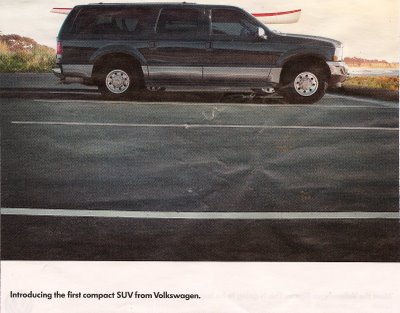
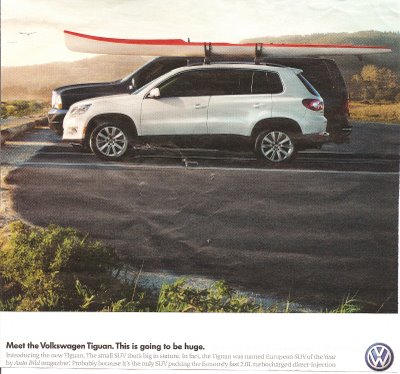
I wonder who the target audience for the Tiguan is supposed to be. And are gas prices finally affecting what people are looking for in vehicles? Is being huge no longer the positive characteristic it was, like, 3 months ago?
Miguel sent us a link to Galeria: Ellas Mandan, a set of advertisements that reverse the common images of male dominance by showing women in control:

For pantyhose:

Shoes:
Jeans:
Dolce & Gabbana:
A submission from Stumblng Tumblr from the Brylcreem website:
NEW! A fashion ad from Phillip G.:
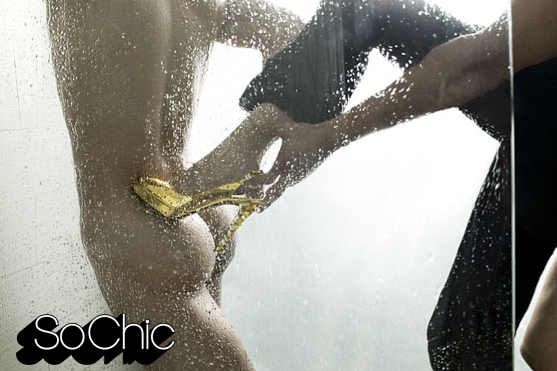
These images show women in “control” of, or dominating men, but in a very sexualized manner that often references S&M or bondage. So women can have power, but have to be sexualized at the same time. This fits in well with our cultural beliefs that women have power over men because men want sex and will allow themselves to be manipulated by women in order to get it. So women can supposedly control men by threatening to withhold sex until they get what they want.
And is it not possible to just have some images where men and women are equals and no one has to be dominant? Is that out of the question?
Thanks, Miguel!

This “Onslaught” ad by Dove has garnered a lot of attention and positive press:
The idea, of course, is that we need to protect our daughters from the images that may harm their self-esteem or make them uncomfortable about their bodies. A great message, no doubt.
However, corporate activism usually has limits and contradictions (as do most things in life, really). Miguel sent us this ad spoof that points out that many of the images the Dove ad says we should be protecting our daughters from are actually used in Axe ads–and Axe is owned by Unilever, the same company that owns Dove.
So Unilever manages to target both markets–those who respond to sexualized images and those who find them harmful–through different brands. This is a common tactic–because large multinational companies own so many different brands, they can market to many different groups of consumers; when we reject one product because of its production process or advertising and buy another instead, there’s a very good chance we’re buying from the same corporate entity, just a different brand name.
As one blogger nicely put it:
It’s a parent’s responsibility to make sure the damaging messages they themselves produce don’t reach your kids.
That is, Dove is telling parents to protect their kids, as if Dove CARES, but Dove’s parent company is producing those very same messages. (It’s kind of like a single corporation owning a beer company and running Alcoholics Anonymous. How very convenient for both.)
A commenter pointed out that Greenpeace made an ad based on Dove’s “Onslaught” commercial that brings up the effects of palm oil production in the destruction of forests in Indonesia:
Thanks, Dangger!
NEW: There is a terrific post at Moment of Choice about one woman’s experience auditioning for a Dove Real Woman commercial. From the post:
Under the guise of looking for women who felt truly comfortable in their own skin, no matter what they looked like, they asked us to bare all or most of it, to prove just how comfortable we really were…A young peppy assistant demonstrated how they wanted us to shake our hands in the air like we just didn’t care and do a full 360 for the camera and male judging panel.
It’s a fascinating inside look at a process most of us never take part in, and reinforces the fact that corporate activism often covers an awful lot of business-as-usual behind the scenes.
It is a norm for women in the U.S. to shave their armpits, but this is not the norm elsewhere, even in countries that have relatively a lot in common with the U.S. (like France I’ve been corrected). How did armpit shaving become the norm in the U.S.? And who benefited from this?
Vee the Monsoon sent us the following commentary and ad. It turns out, women shave in the U.S. today, in part, because of a concerted marketing effort on the part of companies that stood to profit from the creation of such a norm with the creation of anxiety about “objectionable hair.”
From The Straight Dope:
…U.S. women were browbeaten into shaving underarm hair by a sustained marketing assault that began in 1915. (Leg hair came later.) The aim of… the Great Underarm Campaign was to inform American womanhood of a problem that till then it didn’t know it had, namely unsightly underarm hair. To be sure, women had been concerned about the appearance of their hair since time immemorial, but (sensibly) only the stuff you could see. Prior to World War I this meant scalp and, for an unlucky few, facial hair. Around 1915, however, sleeveless dresses became popular, opening up a whole new field of female vulnerability for marketers to exploit…. the underarm campaign began in May, 1915, in Harper’s Bazaar, a magazine aimed at the upper crust. The first ad ‘featured a waist-up photograph of a young woman who appears to be dressed in a slip with a toga-like outfit covering one shoulder. Her arms are arched over her head revealing perfectly clear armpits. The first part of the ad read “Summer Dress and Modern Dancing combine to make necessary the removal of objectionable
hair.
From the May 1915 issue of Harper’s Bazaar:
Thanks Vee!
NEW! Another example from the U.K., 1934 (found here). This one encourages the dissolving of armpit hair as a way to fight armpit odor:
Jane created this awesome visual of how brands inhabit our lives, from dawn until dusk:

Thanks to Kevin for sending it along!
In this series, I offer a typology reflecting the ways in which people of color are used in advertising aimed primarily at whites (see the first and the second in the series). In this, the third edition, I suggest that sometimes people of color are included because the idea of “diversity” triggers the related ideas of “cool,” “hip,” “urban,” and “youth,” which also invoke “modernity” and the idea of being “global,” “cosmopolitan,” even “progressive” politics.
In this ad, a mix of races are used. Notice that the ad also happens to include, in the bottom image, photography, what looks like a dark beer, and espresso (all “upper class” “sophisticated” interests) and, in the top image, we see that the woman who appears Asian is an art dealer.

In this next ad, again, we see a mix of races enjoying what looks like a train ride (how European!) with hard liquor. The text:
The shortest distance between two places isn’t nearly as interesting.
I think it is no accident that “interesting” and racial difference are both present in this ad.

In this next ad we see a racially ambiguous male and a black woman. Notice the clothes that they are wearing (casually sophisticated) and the delicate nature of their coffee cups. This is leisure, not some working-class Joe with a cup o’ joe. Text:
3658 miles from the coffee fields of the Columbian Andes. But still the perfect climate for Colombian Coffee.
The idea of travel, of course, invokes a certain degree of cosmopolitan-ness and wealth. And the “perfect” climate refers not just to weather, but to the kind of company Colombian Coffee drinkers keep.

This ad for H&M is a bit different. Instead of invoking sophistication and cosmopolitan-ness, I think it invokes who and what is “hip” and “cool” and “diversity” is used as a signifier. The text:
H&M is Europe’s leading fashion retailer [Europe again], with over 850 stores worldwide [a reference to being “global”]. Offering high-fashion [i.e., “sophisticated?”] and quality for men, women and children at great prices.

These last two ads, instead of using people of color to emphasize being “hip” or “sophisticated,” use them to signal “youth” and what being young represents. Young people are on the forefront of “cool,” of course, and also, in some sense, define “progressive” in that they herald a more “diverse” and “tolerant” future (hello, Obama).


Next up: Including people of color so as to trigger the idea of human diversity.
Don’t miss the others in the series:
(1) Including people of color so as to associate the product with the racial stereotype.
(2) Including people of color to invoke (literally) the idea of “color” or “flavor.”
I’m always interested when I see ads that play on parents’ fears of neglecting their children as a way to sell them stuff. Middle and upper-middle class parents often encounter, and adopt, a parenting ideology that requires the input of lots of money, time, and emotional energy to be a “good” parent. Parenting is commodified into a set of things parents feel a lot of pressure to buy to prove that they love their children and care about their futures–and don’t want them to be social outcasts.
My mom got pregnant with me when she was 16 and I grew up decidedly working class, and the parenting style I was used to was basically, “The kid’s still alive, so I guess I did a pretty good job.” My mom may have taken this attitude to extremes a bit, since she was known to put me in a harness and tie me out to the clothesline so she didn’t have to keep such a close eye on me when she was busy around the house. Give her a break–she was a teenager! It seemed like a really good idea! (And admit it: there’s part of you that is thinking, “That’s brilliant!”)
My point is, I’m always interested in the ways we seem to always be raising the bar on what is considered good parenting, and “good” parenting is usually defined by middle class standards–though we also often criticize middle and upper-middle class parents for supposedly being distant and self-centered and for pushing their kids too much to succeed. So it’s a catch-22: working-class parents don’t have the money to buy a lot of the products or services we think loving parents must provide their kids, and middle-class parents who do provide them may be criticized for doing so.
Anyway, the other day I came upon these two ads, both of which try to sell products by making parents afraid that if they don’t, they’ll be neglecting their kids. This first one makes it clear that this tactic isn’t new; it’s from 1919:

I found it in the article “Standardizing Childrearing through Housing,” by Paul C. Lukin and Suzanne Vaughan, in Social Problems, volume 53, issue 3, p. 299-331 (the poster is on p. 310).
I found this ad in a Las Vegas community magazine. The text lets you know that silver crowns can be unattractive, and that for your child’s sake you better pay for the white fillings (which are more expensive, and the extra cost is often not covered by dental insurance, even when people have it). I also like that metal fillings are called “bling.” Awesome.

Some of the text below the picture:
Being able to see the dental work in your child’s mouth is not always an appealing appearance. A healthy, natural looking smile for your child is our goal…Now you have a choice!
This is a two-page ad for the Tiguan, a “compact” SUV from Volkswagen. Whereas most SUV ads stress how big and powerful they are (often using images and language that associate them explicitly with masculinity), this one does the opposite–its small size compared to other SUVs is an asset in these ads.


I wonder who the target audience for the Tiguan is supposed to be. And are gas prices finally affecting what people are looking for in vehicles? Is being huge no longer the positive characteristic it was, like, 3 months ago?
Miguel sent us a link to Galeria: Ellas Mandan, a set of advertisements that reverse the common images of male dominance by showing women in control:

For pantyhose:

Shoes:
Jeans:
Dolce & Gabbana:
A submission from Stumblng Tumblr from the Brylcreem website:
NEW! A fashion ad from Phillip G.:

These images show women in “control” of, or dominating men, but in a very sexualized manner that often references S&M or bondage. So women can have power, but have to be sexualized at the same time. This fits in well with our cultural beliefs that women have power over men because men want sex and will allow themselves to be manipulated by women in order to get it. So women can supposedly control men by threatening to withhold sex until they get what they want.
And is it not possible to just have some images where men and women are equals and no one has to be dominant? Is that out of the question?
Thanks, Miguel!

This “Onslaught” ad by Dove has garnered a lot of attention and positive press:
The idea, of course, is that we need to protect our daughters from the images that may harm their self-esteem or make them uncomfortable about their bodies. A great message, no doubt.
However, corporate activism usually has limits and contradictions (as do most things in life, really). Miguel sent us this ad spoof that points out that many of the images the Dove ad says we should be protecting our daughters from are actually used in Axe ads–and Axe is owned by Unilever, the same company that owns Dove.
So Unilever manages to target both markets–those who respond to sexualized images and those who find them harmful–through different brands. This is a common tactic–because large multinational companies own so many different brands, they can market to many different groups of consumers; when we reject one product because of its production process or advertising and buy another instead, there’s a very good chance we’re buying from the same corporate entity, just a different brand name.
As one blogger nicely put it:
It’s a parent’s responsibility to make sure the damaging messages they themselves produce don’t reach your kids.
That is, Dove is telling parents to protect their kids, as if Dove CARES, but Dove’s parent company is producing those very same messages. (It’s kind of like a single corporation owning a beer company and running Alcoholics Anonymous. How very convenient for both.)
A commenter pointed out that Greenpeace made an ad based on Dove’s “Onslaught” commercial that brings up the effects of palm oil production in the destruction of forests in Indonesia:
Thanks, Dangger!
NEW: There is a terrific post at Moment of Choice about one woman’s experience auditioning for a Dove Real Woman commercial. From the post:
Under the guise of looking for women who felt truly comfortable in their own skin, no matter what they looked like, they asked us to bare all or most of it, to prove just how comfortable we really were…A young peppy assistant demonstrated how they wanted us to shake our hands in the air like we just didn’t care and do a full 360 for the camera and male judging panel.
It’s a fascinating inside look at a process most of us never take part in, and reinforces the fact that corporate activism often covers an awful lot of business-as-usual behind the scenes.
It is a norm for women in the U.S. to shave their armpits, but this is not the norm elsewhere, even in countries that have relatively a lot in common with the U.S. (like France I’ve been corrected). How did armpit shaving become the norm in the U.S.? And who benefited from this?
Vee the Monsoon sent us the following commentary and ad. It turns out, women shave in the U.S. today, in part, because of a concerted marketing effort on the part of companies that stood to profit from the creation of such a norm with the creation of anxiety about “objectionable hair.”
From The Straight Dope:
…U.S. women were browbeaten into shaving underarm hair by a sustained marketing assault that began in 1915. (Leg hair came later.) The aim of… the Great Underarm Campaign was to inform American womanhood of a problem that till then it didn’t know it had, namely unsightly underarm hair. To be sure, women had been concerned about the appearance of their hair since time immemorial, but (sensibly) only the stuff you could see. Prior to World War I this meant scalp and, for an unlucky few, facial hair. Around 1915, however, sleeveless dresses became popular, opening up a whole new field of female vulnerability for marketers to exploit…. the underarm campaign began in May, 1915, in Harper’s Bazaar, a magazine aimed at the upper crust. The first ad ‘featured a waist-up photograph of a young woman who appears to be dressed in a slip with a toga-like outfit covering one shoulder. Her arms are arched over her head revealing perfectly clear armpits. The first part of the ad read “Summer Dress and Modern Dancing combine to make necessary the removal of objectionable
hair.
From the May 1915 issue of Harper’s Bazaar:
Thanks Vee!
NEW! Another example from the U.K., 1934 (found here). This one encourages the dissolving of armpit hair as a way to fight armpit odor:
Jane created this awesome visual of how brands inhabit our lives, from dawn until dusk:

Thanks to Kevin for sending it along!




